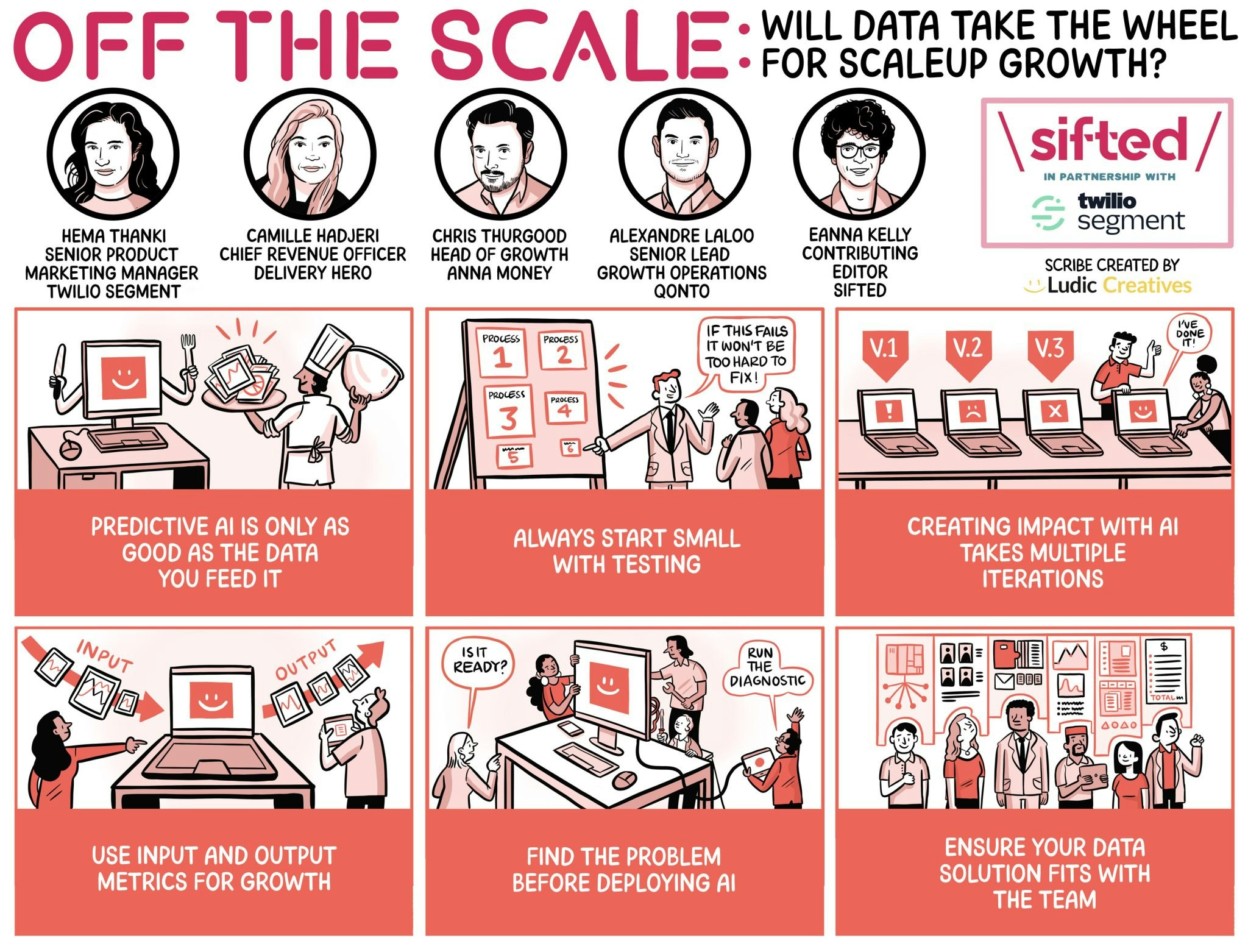Being a data-driven startup simply means that business decisions are made by leaning on datasets – but the reality of implementing this can be anything but simple.
While such an approach has key benefits for businesses — like removing human bias and heightened transparency for decision-making — the lack of nuance can prove challenging.
In our latest edition of Sifted Talks, we explored how to sharpen up your data strategy, use data to stand out from the competition and the role AI plays in it all. Our speakers were:
- Chris Thurgood, head of growth at ANNA Money
- Hema Thanki, senior product marketing manager at Twilio Segment
- Camille Hadjéri, chief revenue officer at Delivery Hero Europe
- Alexandre Laloo, senior lead growth operations at Qonto
Here are the key takeaways from the panel:

1/ Predictive AI is only as good as the data you feed it
The panel discussed the emergence of predictive AI (using machine learning to identify past patterns and use them to predict future events) and its potential capabilities for businesses as a whole, as well as marketers more specifically.
Thanki said the critical element of predictive AI is making sure you have the right data in the first place because such AI is “only as good as the data you’re feeding it”. But she noted that predictive AI is a very easy tool to use once you have that data ready.
For example, if you wanted to predict the likelihood of somebody purchasing a specific product and you wanted to clear stock levels, a business could ask predictive AI what the best product to recommend to a certain person is.
Predictive AI helps to set a foundation as to who could do what, and then teams can decide what to do with that information.” - Hema Thanki, Twilio Segment
2/ Creating impact with AI takes multiple iterations
Laloo noted that accessible AI platforms like ChatGPT have the ability to build products that can change people’s lives – but admitted in the early days of Qonto, the company didn’t acknowledge the necessary learning curve that would come with using such technology.
“It’s not easy building great products with [AI technologies] at first, and it took up a few months and iterations,” he said.
From an execution perspective, this was a sentiment shared by Hadjéri, who recommended testing new AI technology on a small scale first as you don’t know how it will evolve – or if it will even work at all.
Always start small – test if the product works and then when you are confident about it, you can scale.” - Camille Hadjéri, Delivery Hero Europe
3/ Use input and output metrics for growth
Hadjéri said her company’s approach to data is keeping growth and sustainability front and centre of everything they do.
“In each project, we develop very strong KPIs for growth and profitability metrics to have a hygiene factor and make sure that we have sustainable projects,” said Hadjéri.
“We use input metrics versus output metrics – output metrics means your main objective, such as generating revenue via ads. For this example, input metrics could be how many vendors we have that generate ads or what share of type of vendors there are. Input metrics help to generate the output metrics.”
Hadjéri flagged the importance of startups having input metrics to help execute changes that work towards achieving their main mission.
Thanki agreed, noting that working out your end goal is the place to start, allowing you to work backwards and find the data you need to achieve that goal.
People feel they need to track and have every single data piece there is, but actually it’s about prioritising what data is important for your business goals.” - Thanki
4/ Find the problem before deploying AI
AI remains a hot topic, and the panel thought there are different ways to approach strategy and implementation.
Laloo said it’s a trap to think about AI solutions as a way to find a problem – instead, he believes startups should approach it the opposite way.
“We looked at our business-as-usual activities without the lens of AI to look at what could be optimised or was inefficient,” said Laloo. “After we identified the problems, we thought about how we could bring AI into that.”
Thurgood said ANNA Money used AI for different purposes across the business – particularly for both risk and compliance.
For us, it’s about using AI tools to predict and identify challenges in the compliance world before they even happen to protect customers before it’s too late.” - Chris Thurgood, ANNA Money
5/ Ensure your data solution fits with the team
There is no one-size-fits-all data solution. The panel noted the importance of having the right staff in place to make the most of a solution because if not, you may not get the most out of it.
“With the right tool, you need the right people,” said Laloo. “A mistake that’s often made [by startups] is buying a solution that has a lot of different promises about adding value to your business, but you don’t have the right people to deal with the governance of the solution.”
Laloo said that without the right people in place to monitor and run a data solution, there can be constraints to its implementation. Thanki agreed, noting that a tool isn’t going to succeed if you don’t have an internal champion to push it.
Anytime you have a new solution, think about how it will subscribe to your bigger vision and have the right architects to make sure it is implemented in the right way.” - Alexandre Laloo, Qonto
Like this and want more? Watch the full Sifted Talks here:





